| Mediceo Castle | |
|---|---|
Castello Mediceo | |
| Bussi sul Tirino | |
 Castle in Bussi sul Tirino | |
| Type | Castle |
| Site history | |
| Built | 12th century |
Castello Mediceo (Italian for Mediceo Castle) is a Middle Ages castle in Bussi sul Tirino, Province of Pescara (Abruzzo). [1]
| Mediceo Castle | |
|---|---|
Castello Mediceo | |
| Bussi sul Tirino | |
 Castle in Bussi sul Tirino | |
| Type | Castle |
| Site history | |
| Built | 12th century |
Castello Mediceo (Italian for Mediceo Castle) is a Middle Ages castle in Bussi sul Tirino, Province of Pescara (Abruzzo). [1]

The origins of the castle are uncertain, though it was likely built by the d’Angiò family in the 12th century and associated with the monks of San Benedetto in Perillis, who held the small church of Santa Maria di Cartignano. However, a castle must have existed earlier, as it is mentioned in a 1092 donation by a dying Ugo, son of Giliberto, of Frankish origin, who bequeathed the monastery of San Benedetto in Perillis to the Diocese of Valva along with all his possessions, including some assets in the castle of Bussi [2] . Its structure originally had the appearance of a Norman castle, with subsequent modifications by various owners over the centuries. The castle was owned by the Cantelmo dukes of Popoli when they gained full control of the Bussi fief. In the 16th century, the castle became the property of the Pietropaoli counts of Navelli and later of the de’ Medici family. The subsequent history is uncertain until the second half of the 18th century when, after the fall of the feudal system, the current noble family owners, originating from the de Sanctis barons of Rocca Casale, acquired the main structure, except for the outer walls incorporated into the town.
In the 20th century, the castle was renowned in the region for being one of the richest and best-preserved, thanks to restoration and complete renovation by Orazio de Sanctis in the early part of the century, including the reconstruction of the partially ruined tower after previous structural tampering and destructive events culminating in the German military occupation during World War II.
The building has a rectangular layout with an elegant internal courtyard. The prominent feature is the large rectangular tower with a battlemented roof (with partially artificial battlements) adorned with machicolations. The facade resembles that of a noble palace, as do the rest of the castle’s sides.
The interior maintains its original rooms and chambers, furnished with period pieces, most of which were replenished in the early 20th century following the aforementioned destructive events.

The province of L'Aquila is the largest, most mountainous and least densely populated province of the Abruzzo region of Italy. It comprises about half the landmass of Abruzzo and occupies the western part of the region. It has borders with the provinces of Teramo to the north, Pescara and Chieti to the east, Isernia to the south and Frosinone, Rome and Rieti to the west. Its capital is the city of L'Aquila.

The province of Pescara is a province in the Abruzzo region of Italy. Its capital is the city of Pescara, which has a population of 119,483 inhabitants. As of 2017, it has a total population of 319,936 inhabitants over an area of 1,230.33 square kilometres (475.03 sq mi). The provincial president is Antonio Zaffiri and the province contains 46 comuni.

Capestrano is a comune and small town with 885 inhabitants (2017), in the Province of L'Aquila, Abruzzo, Italy. It is located in the Gran Sasso e Monti della Laga National Park.

Bussi sul Tirino is a comune and town in the province of Pescara in the Abruzzo region of Italy. It is located in the Gran Sasso e Monti della Laga National Park.

The Gran Sasso and Monti della Laga National Park is a natural park in central Italy. Established in 1991, it covers an area of 2,014 square kilometres (778 sq mi), mostly within the provinces of Teramo, L'Aquila, and Pescara in Abruzzo, with small areas in the provinces of Rieti in Lazio and Ascoli Piceno in Marche. The terrain is predominantly mountainous with alpine plains.
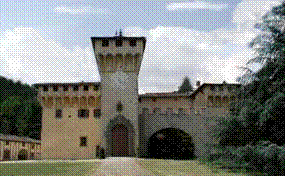
The Villa Medicea di Cafaggiolo is a villa situated near the Tuscan town of Barberino di Mugello in the valley of the River Sieve, some 25 kilometres north of Florence, central Italy. It was one of the oldest and most favoured of the Medici family estates, having been in the possession of the family since the 14th century, when it was owned by Averardo de' Medici. Averardo's son, Giovanni di Bicci de' Medici, is considered to be the founder of the Medici dynasty.

Torrechiara Castle is a 15th-century castle near Langhirano, in the province of Parma, northern Italy. It sits atop a terraced hill south of the city of Parma, in a strategic position overlooking the Parma River in the valley below. The castle was commissioned by Pier Maria II de' Rossi, the fourth count of San Secondo, and built between 1448 and 1460. The fortress shows the influence of the castles of the House of Sforza, particularly Visconti-Sforza Castle. The castle is managed by the Polo Museale dell'Emilia Romagna since 2015.
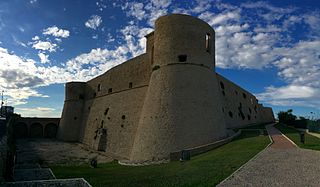
Castello aragonese is a Renaissance castle in Ortona, Province of Chieti (Abruzzo).

The Castle of Barisciano is a medieval castle in Barisciano, province of L'Aquila, Abruzzo, southern Italy.

Castello di Ocre is a medieval castle in Ocre, Province of L'Aquila, Abruzzo, southern Italy.
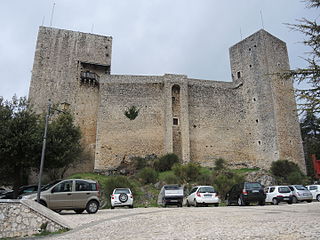
Castello di Pereto is a Middle Ages castle in Pereto, Province of L'Aquila (Abruzzo), Italy.

Castello De Sanctis is a Middle Ages castle in Roccacasale, Province of L'Aquila (Abruzzo).

Castello Masciantonio is a Renaissance castle in Casoli, Province of Chieti (Abruzzo).
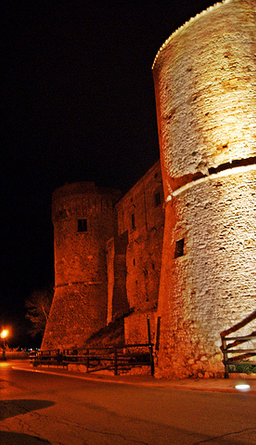
Castello di Monteodorisio is a Middle Ages castle in Monteodorisio, Province of Chieti (Abruzzo).

Castello di Roccascalegna is a medieval castle in Roccascalegna, Province of Chieti, Abruzzo, southern Italy.

Castello di Salle is a Middle Ages castle in Salle, Province of Pescara, Abruzzo, Italy.

The Ducal Castle of Carpineto Sinello is a Renaissance castle in Carpineto Sinello, province of Chieti, Abruzzo, southern Italy.
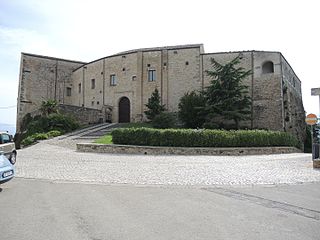
Castello De Sterlich-Aliprandi is a fortified palace in Nocciano, Province of Pescara (Abruzzo).

The Visconti Castle of Legnano is a mediaeval castle, located south of the city of Legnano, Metropolitan City of Milan, Lombardy, northern Italy. It lies on a small island formed by the Olona river. Since the 13th century, it is also known as the castle of San Giorgio.
{{cite book}}: CS1 maint: location missing publisher (link)